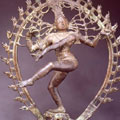|
|
 |
 |
| Introduction |
|
|
By Anne Murphy, independent scholar
Hindu religious images or icons (murti) are found in a variety of settings: indoors, in a temple or in a personal or family shrine; or outdoors, in a road or riverside shrine (Figure 1). Images may portray one of the great Gods of Hinduism -- the most popular are Shiva, Vishnu, and the Goddess -- or one of the many local and regional deities that comprise the Hindu pantheon (Figure 2). Such images allow devotees direct access to God, who is thought to be fully present in the icon. Visual exchange with the sacred image (darshan) is a primary mode of religious practice for many Hindus: devotees both see the image and are seen by it.
Visual representations of God are important to many but not all forms of Hindu religious practice. Two general modes of understanding divinity can be distinguished in Hindu thought: a divinity could be "without qualities" (nirguna) or "with qualities" (saguna). The 16th-century Indian poet-saint Ravidas, for example, sang of the divine as a formless, unknowable nirguna Lord, a transcendent God who could not be known through a physical form. The alternative view of God was held by the poet-saint Surdas, who extolled the virtues of the boy-God Krishna, an incarnation or avatara of the great God Vishnu. Surdas' Krishna was a celebration of the senses in every way: in the beauty of his eyes, in the lilting tune of his flute, and in the dark luster of his skin. Both approaches to God persist in modern-day Hinduism. Most adherents of the Arya Samaj, a school founded in the 19th century, eschew reliance upon images in worship, while those who follow what they call Sanatan Dharm (the "eternal religion") assert the validity of images as a means of worshiping and interacting with the divine. It should be no surprise that there are different ways of understanding images of God within the Hindu tradition, since the term "Hinduism" itself came into general use only in the course of the last two centuries, and is applied to a wide array of beliefs and practices.
Images had come to occupy a central place in Hindu devotional worship and ritual by the first millennium. Their growth in importance was accompanied by the proliferation and expansion of temples, which were built to house the embodiment of the living divine personality. These increasingly ornate structures represented a microcosm of the universe and a testament to the power and presence of the divinity, while also attesting to the power and authority of the kings who sponsored them. Temples came to occupy a prominent place in the social and religious landscape of the regional kingdoms that dominated political life in South Asia from the 9th to the 15th century, until the consolidation of centralized powers in the north under rulers from West Asia. Hinduism also took root in Southeast Asia in the early centuries of the first millennium, where it was similarly tied to the assertion and maintenance of authority on the part of local rulers. Together with Buddhism, another Indian religion adapted to the Southeast Asian cultural environment, Hinduism has continued to exert an enduring influence into the modern period in this part of the world, particularly in Bali (Indonesia). In addition, Hindu religious images also occupy a prominent place among the members of South Asia's Hindu diaspora communities in London and New York City, as well as among Western converts.
The images in this resource represent the saguna or "with qualities" understanding of God. Most of the images are human-made, but stones, fossils, trees, and other naturally occurring substances are also forms of icons, as representations or embodiments of God. Natural features of the environment, such as rivers, may also be seen as images or embodiments of divinity. The Ganga (known outside India as the Ganges) is both a physical river and a Goddess, commonly portrayed as a beautiful woman. Unlike naturally occurring images, human-made images are usually anthropomorphic (Figure 2). An important exception is the shiva linga, the non-anthropomorphic (aniconic) form of the great God Shiva that usually occupies the central place in temples dedicated to that God (Figure 3). The shiva linga is considered more important than images of the God in human form, and can be human-made or naturally occurring. In devotional contexts, images of all types are often adorned in sumptuous attire and presented with offerings from devotees (Figure 1); they are honored as direct representatives and, in many cases, actual embodiments of God.
next >
Top |
|
 |
 |
| Click for details |
 |
 |
 |
Fig. 1
|
 |
 |
 |
Fig. 2
|
 |
 |
 |
Fig. 3
|
 |
|
 |


